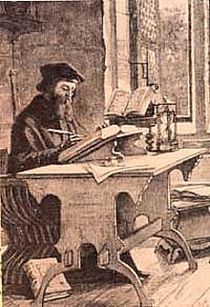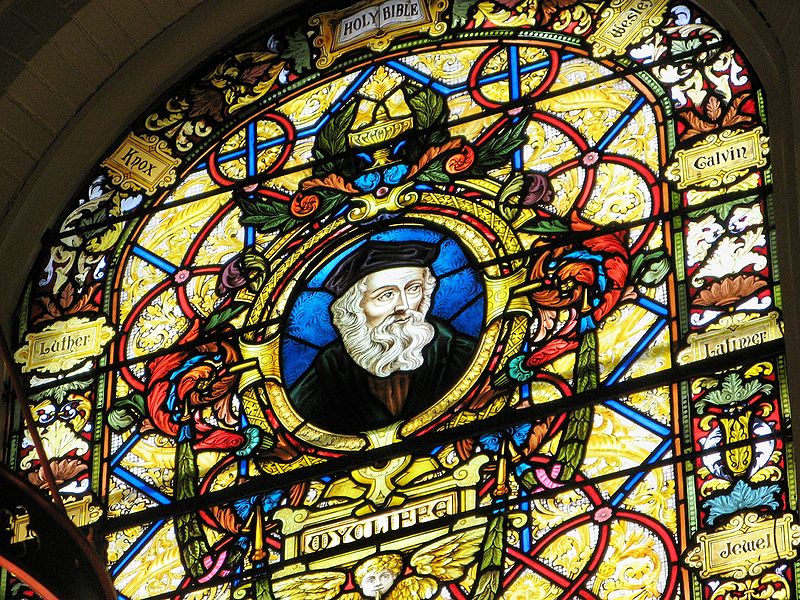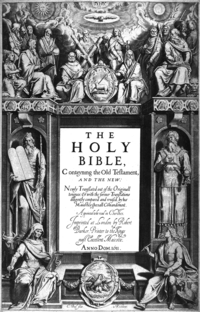
2 Peter 1:19-20 (KJV)
19 We have also a more sure word of prophecy; where unto ye do well that ye take heed, as unto a light that shineth in a dark place, until the day dawn, and the day star arise in your hearts:
20 Knowing this first, that no prophecy of the scripture is of any private interpretation.
In May 1601, King James VI of Scotland attended the General Assembly of the Church of Scotland at St Columba's Church in Burntisland, Fife, at which proposals were put forward for a new translation of the Bible into English.Two years later, he ascended to the throne of England as King James I of England.
Considerations for a new version
The newly crowned King James convened the Hampton Court Conference in 1604. That gathering proposed a new English version in response to the perceived problems of earlier translations as detected by the Puritan faction of the Church of England. Here are three examples of problems the Puritans perceived with the Bishops and Great Bibles:
First, Galatians iv. 25 (from the Bishops' Bible). The Greek word susoichei is not well translated as now it is, bordereth neither expressing the force of the word, nor the apostle's sense, nor the situation of the place. Secondly, psalm cv. 28 (from the Great Bible), 'They were not obedient;' the original being, 'They were not disobedient.' Thirdly, psalm cvi. 30 (also from the Great Bible), 'Then stood up Phinees and prayed,' the Hebrew hath, 'executed judgment.'
In 1604, King James I of England authorized that a new translation of the Bible into English be started. It was finished in 1611, just 85 years after the first translation of the New Testament into English appeared (Tyndale, 1526).
The Authorized Version, or King James Version, quickly became the standard for English-speaking Protestants.
Its flowing language and prose rhythm has had a profound influence on the literature of the past 400 years. The King James Version present on the Bible Gateway matches the 1987 printing. The KJV is public domain in the United States.
Matthew 24:35 Heaven and earth shall pass away, but my words shall not pass away
Who Is King James...

The kingdoms of Scotland and England were individual sovereign states, with their own parliaments, judiciary, and laws, though both were ruled by James in personal union.
King James gave the translators instructions to write the bible from God words in the holy scroll of the old and new testments in order to get under bound by the Roman Catholic Church to be give to the world they landage to read the Holy Bible...
king james had a wife Anne of Denmark (Danish: Anna; 12 December 1574 – 2 March 1619) was Queen consort of Scotland, England, and Ireland as the wife of King James VI and I.
By all accounts, James was at first entranced by his bride, but his infatuation evaporated quickly and the couple often found themselves at loggerheads, though in the early years of their marriage, James seems always to have treated Anne with patience and affection.
Between 1593 and 1595, James was romantically linked with Anne Murray, later Lady Glamis, whom he addressed in verse as "my mistress and my love"; and Anne herself was also occasionally the subject of scandalous rumours.
In Basilikon Doron, written 1597–1598, James described marriage as "the greatest earthly felicitie or miserie, that can come to a man".
From the first moment of the marriage, Anne was under pressure to provide James and Scotland with an heir,[but the passing of 1591 and 1592 with no sign of a pregnancy provoked renewed.
Presbyterian libels on the theme of James' fondness for male company and whispers against Anne "for that she proves not with child".[49] As a result, there was great public relief when on 19 February 1594 Anne gave birth to her first child, Henry Frederick.
Anne gave birth to seven children who survived beyond childbirth, four of whom died in infancy or early childhood;[she also suffered at least three miscarriages.
Her second son succeeded James as King Charles I. Her daughter Elizabeth was the "Winter Queen" of Bohemia and the grandmother of King George I of Great Britain.
Henry Frederick, Prince of Wales (19 February 1594 – 6 November 1612). Died, probably of typhoid fever, aged 18.
miscarriage (July 1595).
Elizabeth (19 August 1596 – 13 February 1662). Married 1613, Frederick V, Elector Palatine. Died aged 65.
Margaret (24 December 1598 Dalkeith Palace – March 1600 Linlithgow Palace). Died aged fifteen months. Buried at Holyrood Abbey.
Charles I of England (19 November 1600 – 30 January 1649). Married 1625, Henrietta Maria. Executed aged 48.
Robert, Duke of Kintyre (18 January 1602 – 27 May 1602). Died aged four months.
miscarriage (10 May 1603).
Mary (8 April 1605 Greenwich Palace – 16 December 1607 Stanwell, Surrey). Died aged two.
Sophia (22 June 1606 – 23 June 1606). Born and died at Greenwich Palace.
James's sexuality is a matter of dispute. Throughout his life James had close relationships with male courtiers, which has caused debate among historians about their exact nature.
After his accession in England, his peaceful and scholarly attitude contrasted strikingly with the bellicose and flirtatious behaviour of Elizabeth, as indicated by the contemporary epigram Rex fuit Elizabeth, nunc est regina Jacobus (Elizabeth was King, now James is Queen
Some of James's biographers conclude that Esmé Stewart (later Duke of Lennox), Robert Carr (later Earl of Somerset), and George Villiers (later Duke of Buckingham) were his lovers.
Sir John Oglander observed that he "never yet saw any fond husband make so much or so great dalliance over his beautiful spouse as I have seen King James over his favourites, especially the Duke of Buckingham" whom the King would, recalled Sir Edward Peyton, "tumble and kiss as a mistress."
Restoration of Apethorpe Palace undertaken in 2004–08 revealed a previously unknown passage linking the bedchambers of James and Villiers.
Some biographers of James argue that the relationships were not sexual.James's Basilikon Doron lists sodomy among crimes "ye are bound in conscience never to forgive", and James's wife Anne gave birth to seven live children, as well as suffering two stillbirths and at least three other miscarriages.
Contemporary Huguenot poet Théophile de Viau observed that "it is well known that the king of England / has union with the Duke of Buckingham".[
Buckingham himself provides evidence that he slept in the same bed as the King, writing to James many years later that he had pondered "whether you loved me now ... better than at the time which I shall never forget at Farnham, where the bed's head could not be found between the master and his dog".[
Buckingham's words may be interpreted as non-sexual, in the context of seventeenth-century court life, and remain ambiguous.
It all started with John Wycliffe...

Wycliffe (/ˈwɪklɪf/; also spelled Wyclif, Wycliff, Wiclef, Wicliffe, Wickliffe; c. mid-1320s – 31 December 1384) He was an English scholastic philosopher, theologian, Biblical translator, reformer, and seminary professor at Oxford. He was an influential dissident within the Roman Catholic priesthood during the 14th century.
Wycliffe had come to regard the scriptures as the only reliable guide to the truth about God, and maintained that all Christians should rely on the Bible rather than on the teachings of popes and clerics. He said that there was no scriptural justification for the papacy.
Theologically, his preaching expressed a strong belief in predestination that enabled him to declare an "invisible church of the elect", made up of those predestined to be saved, rather than in the "visible" Catholic Church.To Wycliffe, the Church was the totality of those who are predestined to blessedness. No one who is eternally lost has part in it. There is one universal Church, and outside of it there is no salvation.
His first tracts and greater works of ecclesiastical-political content defended the privileges of the State.
By 1379 in his De ecclesia ("On the Church"), Wycliffe clearly claimed the supremacy of the king over the priesthood.He rejected the concept of purgatory,and disapproved of clerical celibacy, pilgrimages, the selling of indulgences and praying to saints.
It was Wycliffe who recognised and formulated one of the two major formal principles of the Reformation—the unique authority of the Bible for the belief and life of the Christian.
Wycliffe attacked the privileged status of the clergy, which was central to their powerful role in England. He then attacked the luxury and pomp of local parishes and their ceremonies.
Wycliffe was also an advocate for translation of the Bible into the vernacular. He completed a translation directly from the Vulgate into Middle English in the year 1382, now known as Wycliffe's Bible.
It is probable that he personally translated the Gospels of Matthew, Mark, Luke, and John; and it is possible he translated the entire New Testament, while his associates translated the Old Testament.
Wycliffe's Bible appears to have been completed by 1384, with additional updated versions being done by Wycliffe's assistant John Purvey and others in 1388 and 1395.
The Council of Constance Roman Catholic declared Wycliffe a heretic on 4 May 1415, and banned his writings, effectively both excommunicating him retroactively and making him an early forerunner of Protestantism.
The Council decreed that Wycliffe's works should be burned and his remains removed from consecrated ground.
This order, confirmed by Pope Martin V, was carried out in 1428.Wycliffe's corpse was exhumed and burned and the ashes cast into the River Swift, which flows through Lutterworth.
John Wycliffe Legacy...

A stained glass window in Wycliffe College Chapel, Toronto
Wycliffe was instrumental in the development of a translation of the Bible in English, thus making it accessible to laypeople. He also had a strong influence on Jan Hus.
Wycliffe Bible Translators, one of the world's largest international organisations dedicated to
translating the Bible into modern languages is named in honour of John Wycliffe.
Wycliffe Hall, Oxford, one of the Church of England's designated Evangelical theological colleges.
Wycliffe College at the University of Toronto
Wycliffe College (Gloucestershire)
Wycliffe Saw The Evil Of The Roman Catholic Church...
God Wanted His Word To Spread About..Do You Think???
The newly crowned King James convened the Hampton Court Conference in 1604. That gathering proposed a new English version in response to the perceived problems of earlier translations as detected by the Puritan faction of the Church of England.
An English translation of the Christian Bible for the Church of England begun in 1604 and completed in 1611.The books of the King James Version include the 39 books of the Old Testament, an intertestamental section containing 14 books of the Apocrypha, and the 27 books of the New Testament.
Considerations for a new version
James' instructions included several requirements that kept the new translation familiar to its listeners and reader.
The King James version contains several mistranslations; especially in the Old Testament where the knowledge of Hebrew and cognate languages was uncertain at the time.
Old Testament
In the Old Testament the translators render the Tetragrammaton YHWH by "the LORD" (in later editions in small capitals as LORD),[d] or "the LORD God" (for YHWH Elohim, יהוה אלהים),[e] except in four places by "IEHOVAH" (Exodus 6:3, Psalm 83:18, Isaiah 12:2 and Isaiah 26:4) and three times in a combination form.
(Genesis 22:14, Exodus 17:15, Judges 6:24) However, if the Tetragrammaton occurs with the Hebrew word adonai (Lord) then it is rendered not as the "Lord LORD" but as the "Lord God". (Psalm 73:28,etc.) In later editions as "Lord GOD" with "GOD" in small capitals indicating to the reader that God's name appears in the original Hebrew.
A number of Bible verses in the King James Version of the New Testament are not found in more recent Bible translations; where these are based on modern critical texts.
In the early seventeenth century, the source Greek texts of the New Testament used for the production of Protestant bible versions depended mainly on manuscripts of the late Byzantine text-type, and with minor variations contained what became known as the Textus Receptus.
With the subsequent identification of much earlier manuscripts, most modern textual scholars value the evidence of manuscripts belonging to the Alexandrian family as better witnesses to the original text of the biblical authors, without giving it, or any family, automatic preference.
the King gave the translators instructions designed to guarantee that the new version would conform to the ecclesiology of the Church of England.Certain Greek and Hebrew words were to be translated in a manner that reflected the traditional usage of the church.
For example, old ecclesiastical words such as the word "church" were to be retained and not to be translated as "congregation".The new translation would reflect the episcopal structure of the Church of England and traditional beliefs about ordained clergy.
The task of translation was undertaken by 47 scholars, although 54 were originally approved.[8] All were members of the Church of England and all except Sir Henry Savile were clergy. The scholars worked in six committees, two based in each of the University of Oxford, the University of Cambridge, and Westminster. The committees included scholars with Puritan sympathies, as well as High Churchmen.
Forty unbound copies of the 1602 edition of the Bishops' Bible were specially printed so that the agreed changes of each committee could be recorded in the margins. The committees worked on certain parts separately and the drafts produced by each committee were then compared and revised for harmony with each other.
The scholars were not paid directly for their translation work, instead a circular letter was sent to bishops encouraging them to consider the translators for appointment to well-paid livings as these fell vacant.
Several were supported by the various colleges at Oxford and Cambridge, while others were promoted to bishoprics, deaneries and prebends through royal patronage.
The committees started work towards the end of 1604. King James I of England, on 22 July 1604, sent a letter to Archbishop Bancroft asking him to contact all English churchmen requesting that they make donations to his project.

The title page to the 1611 first edition of the Authorized Version of the Bible by Cornelis Boel shows the Apostles Peter and Paul seated centrally above the central text, which is flanked by Moses and Aaron. In the four corners sit Matthew, Mark, Luke and John, authors of the four gospels, with their symbolic animals. The rest of the Apostles (with Judas facing away) stand around Peter and Paul. At the very top is the Tetragrammaton "יְהֹוָה" written with Hebrew diacritics.
King James gave the translators instructions intended to ensure that the new version would conform to the ecclesiology and reflect the episcopal structure of the Church of England and its belief in an ordained clergy.The translation was done by 47 scholars, all of whom were members of the Church of England.
In common with most other translations of the period, the New Testament was translated from Greek, the Old Testament from Hebrew and Aramaic, and the Apocrypha from Greek and Latin.
In the Book of Common Prayer (1662), the text of the Authorized Version replaced the text of the Great Bible for Epistle and Gospel readings (but not for the Psalter, which substantially retained Coverdale's Great Bible version) and as such was authorised by Act of Parliament.
No comments:
Post a Comment